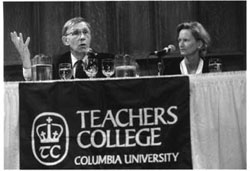The Children Are Watching: How the Media Teach About Diversity
Can movies, television shows and newspapers be considered textbooks? Author and media expert Carlos Cortés from the University of California, Riverside said, "The Media teaches because their products-programs, papers and magazines-serve as textbooks on democracy."
He added, "The media curriculum becomes a chaotic series of many voices when all the textbooks are put together-it becomes an unplanned curriculum."
Through his book, The Children Are Watching: How the Media Teach About Diversity, which he discussed at the TC BookTalk in October, Cortés analyzed how the media frames diversity-related issues, transmits certain values, and contributes to stereotypes.
These "textbooks" created by the media or "media educators" as Cortés labels them, have the power to influence the way people think. He said, "These textbooks are continuously rewritten and often inaccurately."
Since both the media and schools educate, he made a distinction between the "media educators" and "school educators." Since society imposes responsibilities and licensing on school educators, Cortés said he would "love to get the media to admit that they teach." However, he said, the media will never do this. They see themselves as entertainers, not teachers.
Cortés said that he likes to "hector" the media about this issue. He wouldn't push it past hectoring, though. Getting the government involved to regulate the media might not be a smart idea in Cortés' eyes. "The government could push for changes that would make it worse," he said.
One way to work with this competing curriculum that the media has created is for parents, guardians, silbings, aunts, or uncles to work with it and explain it to their children as a form of "spin control." Cortés recognizes that with today's economic pressure, parents have less time to sit down with kids and explain what is going on to children. "Teachers are in the ideal position to help control this," he said.
Moderator Richard Heffner, host of PBS's The Open Mind, opened up the topic of discussion to panelists TC Associate Professors Margaret Crocco and Maria Torres-Guzman as well as the audience.
Crocco cited a New York Times article about violent videogames and children. She mentioned that many parents think children's privacy rights needed to be protected-they can play the games as long as they are in their own rooms. Cortés said that this is a "generational mania about rights, an easy way out for parents, which ignores responsibility." He further emphasized the need for parents and guardians to watch television with their children and explain what is happening.
Torres-Guzman had concerns about the "reproductive nature" of culture and how it transits from one generation to another, especially in the cases of re-runs, movies, and other means of communication such as the Internet.
Cortés responded with two views on the Internet. He said that it is a form of democratization-anyone can be a media creator with or without proper credentials. In terms of diversity, people can carry on intercultural dialogues and build bridges. However, Cortés said that most people visit the same sites repeatedly and dig deeply into them, as evidenced by hate group sites. He added that the mainstream media looks good compared to the hate sites on the Internet.
Members of the audience raised many interesting questions about the media and diversity. Laurie Behrman, TC student and staff member, asked about the omission of women and minorities in the media. She said one result is that children have a tough time envisioning women and minorities in powerful roles such as doctors or politicians. Women's voices are not as prevalent in the media in general.
Cortés said, "Women's and minorities' voices have not been powerful from the get-go. However, there are some strong voices such as Dr. Laura and Oprah Winfrey, but these voices can be conflicting and contentious." He continued, "Messages aren't getting out to the young girls and women-there is inbreeding so that a very narrow set of women's and minority voices bleed through the rest of the voices."
He gave some ideas on how teachers can alert kids to how the media frames diversity. He advised teachers to look at news stories with kids or focus on groups of people in the media and look at how they are described by the media.
Cortés' book is the first one to address the connection of schools and media in this way. He hopes that school administrators and parents "realize that by not understanding the media, they are undermining their child's education."
Published Monday, Jun. 10, 2002
